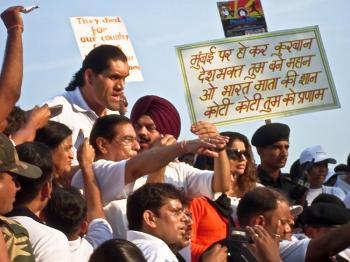MUMBAI, India—Two days after the central Indian government initiated the formation a separate state of Telangana, a volley of protests erupted across the state of Andhra Pradesh, all major political parties were vertically split and 134 members of the legislative assembly (MLAs) of non-Telangana regions, submitted their resignations. The political crisis in Andhra Pradesh over the proposed Telangana statehood deepened on Saturday when 20 ministers resigned from the cabinet.
Ministers from Andhra and Rayalseema met in Hyderabad, the capital city of Andhra Pradesh, and unanimously decided to fight for an integrated Andhra Pradesh. A.R. Reddy, minister for municipal administration said, “We hope that the central and the state government will take appropriate action to ensure the unity of the state.”
In a damage control effort, Prime Minister Manmohan Singh assured members of Parliament from the coastal Andhra and Rayalseema regions that no decision “will be taken in haste.” And, Congress now says that there will be no resolution if there is no consensus.
Congress legislators in Telangana have made it clear that nothing less than a separate Telangana will be acceptable to them. “After having taken a bold step, the central government can not go back on it,” said Yadav Reddy, a Congress legislator.
Spearheading the move for Telangana statehood is Telangana Rashtra Samiti (TRS) president, K. Chandrasekhar Rao who had threatened to fast-unto-death before the central government agreed to a separate Telangana state.
Andhra Pradesh was established by the central government in 1956 by merging Telangana with Rayalaseema and Coastal Andhra, based on their linguistic affinity, to form Andhra Pradesh. The merger was made under a Gentleman’s Agreement, under protest from Telangana which felt the agreement was biased. The ‘Gentleman’s Agreement of Andhra Pradesh’ reassured the Telangana people as well as the Andhra people of terms of power-sharing as well as administrative domicile rules and distribution of expenses of various regions. But the agreement was not followed either in spirit or in letter.
Discontent with the Gentlemen’s Agreement intensified in 1969 when the agreed upon guarantees were supposed to lapse.
The movement for a separate Telangana state has been on and off for the last 50 years. It grew out of a sense of regional identity, rather than a sense of ethnic identity, language, religion, or caste. The movement demanded redress for economic grievances by writing a separate history, special consideration for a different policy on education, and the acknowledgment of cultural diversity.
Telangana had numerous complaints about the implementation of agreements and guarantees. For example, though the educational institutions in the region were greatly expanded, Telanganas enrollments were not proportionate to their numbers. Telanganas felt discriminated against in employment as well, but were told by the state government that most non-Telanganas had been hired on the grounds that qualified local people were unavailable.
Many students support the separation of Telangana from Andhra Pradesh. Students in Telangana have been at the forefront of the agitation to separate Telangana, because they have been denied university education. The better primary and secondary school education of the Andhra’s, has left them at a disadvantage in admissions and selection for the courses they wished to pursue. Pratap Antony, a mass communications consultant in Hyderabad says, “The politically incorrect, but very probably true story is that since Telangana was never part of British India, Telangana never had the benefit of the great educational institutions which the British built.”
The emotions and forces generated by the Telangana movement have never been directed against the territorial integrity of India, unlike the insurrections in Jammu and Kashmir and some of the unrest in Northeastern India.
The issue has reached a stalemate, with both sides playing the waiting game the while the central government is forced to rethink. The fallout from the Telangana statehood issue has also initiated a strident chorus of other small independent states across the country who also seek independence.
Bombarded with demands for separate states, the center is now considering setting up a second State Reorganization Commission (SRC), to which the government can hand over all the appeals.
Ministers from Andhra and Rayalseema met in Hyderabad, the capital city of Andhra Pradesh, and unanimously decided to fight for an integrated Andhra Pradesh. A.R. Reddy, minister for municipal administration said, “We hope that the central and the state government will take appropriate action to ensure the unity of the state.”
In a damage control effort, Prime Minister Manmohan Singh assured members of Parliament from the coastal Andhra and Rayalseema regions that no decision “will be taken in haste.” And, Congress now says that there will be no resolution if there is no consensus.
Congress legislators in Telangana have made it clear that nothing less than a separate Telangana will be acceptable to them. “After having taken a bold step, the central government can not go back on it,” said Yadav Reddy, a Congress legislator.
Spearheading the move for Telangana statehood is Telangana Rashtra Samiti (TRS) president, K. Chandrasekhar Rao who had threatened to fast-unto-death before the central government agreed to a separate Telangana state.
Andhra Pradesh was established by the central government in 1956 by merging Telangana with Rayalaseema and Coastal Andhra, based on their linguistic affinity, to form Andhra Pradesh. The merger was made under a Gentleman’s Agreement, under protest from Telangana which felt the agreement was biased. The ‘Gentleman’s Agreement of Andhra Pradesh’ reassured the Telangana people as well as the Andhra people of terms of power-sharing as well as administrative domicile rules and distribution of expenses of various regions. But the agreement was not followed either in spirit or in letter.
Discontent with the Gentlemen’s Agreement intensified in 1969 when the agreed upon guarantees were supposed to lapse.
The movement for a separate Telangana state has been on and off for the last 50 years. It grew out of a sense of regional identity, rather than a sense of ethnic identity, language, religion, or caste. The movement demanded redress for economic grievances by writing a separate history, special consideration for a different policy on education, and the acknowledgment of cultural diversity.
Telangana had numerous complaints about the implementation of agreements and guarantees. For example, though the educational institutions in the region were greatly expanded, Telanganas enrollments were not proportionate to their numbers. Telanganas felt discriminated against in employment as well, but were told by the state government that most non-Telanganas had been hired on the grounds that qualified local people were unavailable.
Many students support the separation of Telangana from Andhra Pradesh. Students in Telangana have been at the forefront of the agitation to separate Telangana, because they have been denied university education. The better primary and secondary school education of the Andhra’s, has left them at a disadvantage in admissions and selection for the courses they wished to pursue. Pratap Antony, a mass communications consultant in Hyderabad says, “The politically incorrect, but very probably true story is that since Telangana was never part of British India, Telangana never had the benefit of the great educational institutions which the British built.”
The emotions and forces generated by the Telangana movement have never been directed against the territorial integrity of India, unlike the insurrections in Jammu and Kashmir and some of the unrest in Northeastern India.
The issue has reached a stalemate, with both sides playing the waiting game the while the central government is forced to rethink. The fallout from the Telangana statehood issue has also initiated a strident chorus of other small independent states across the country who also seek independence.
Bombarded with demands for separate states, the center is now considering setting up a second State Reorganization Commission (SRC), to which the government can hand over all the appeals.



